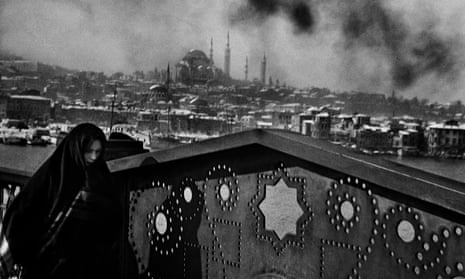Though Ara Güler, who has died aged 90, was a renowned international photojournalist, his great achievement lay in his career-long documentation of his home city, Istanbul. Güler photographed the city affectionately yet authentically, and became known as the “eye of Istanbul”. While he could be positive, poetic and playful, he also showed the harsh reality of life for many of its inhabitants.
Many regard his earlier Istanbul work, in which he seemed to capture the city’s essence, with the greatest fondness. “Ara Güler’s Istanbul is my Istanbul,” wrote the novelist Orhan Pamuk in 2009 in the foreword to the collection Ara Güler’s Istanbul. “The Istanbul of the 1950s and 1960s – its streets, pavements, shops and dirty, neglected factories; its ships, horse carts, buses, clouds, private taxis, shared taxis, buildings, bridges, chimneys, mists and people; and the soul in all these things, so difficult to recognise at first sight – is nowhere as well documented, preserved and protected as it is in the photographs of Ara Güler.”

Pamuk was particularly taken by the hüzün – a kind of melancholy – evoked in many of Güler’s photographs from this period, in which the mosques, the water and smoke from the ships insistently recur. Güler worked in both colour and monochrome, but the black-and-white pictures tend to have more of this melancholic quality, something the photographer recognised, once observing that “colour photographs lack the solidity of black and white”.
Despite the depth and complexity of his pictures, Güler was devoid of artistic pretension. “My aim is not to produce art photography, but simply to reflect Istanbul as it really is,” he said, regarding himself as a documentary photographer as opposed to an artist. “I believe that photography is a form of magic by which a moment of experience is seized for transmission to future generations,” he said.
Photography was not his first choice of profession. He was born in Istanbul to Armenian parents, Dacat Derderyan and Verjin Şahyan; in 1935 a law compelled them to take a Turkish surname.

Initially Ara set his sights on a career in the dramatic arts. He started jobbing in film studios where his father, a pharmacist, had connections through selling chemicals for developing film.
Ara dedicated his 1994 book A Photographical Sketch on Lost Istanbul “to my father Dacat Güler ... for his having bought me my first camera”. He also pursued courses in theatre and wrote plays. While studying economics at the University of Istanbul, he began working as a photographer for the Yeni Istanbul newspaper. He later headed the photography department at the magazine Hayat.
His big break came in December 1958, when the American magazine group Time Life opened an office in Istanbul and hired Güler. This raised his profile internationally, and before long he found himself also working for European titles, particularly Stern, Paris Match and the Sunday Times, regularly travelling abroad on assignment.
In Paris he met Henri Cartier-Bresson who invited him to become the 16th member of the Magnum photographic agency, which then began to distribute his work to more magazines and newspapers globally.
Although he later left Magnum, he retained strong links with and friendships at the co-operative. “Being a Magnum photographer doesn’t make you rich, it makes you proud,” he said in an interview with the British Journal of Photography in 2013, about his decision to leave and pursue an independent career. “I’m never going to retire. I will take photographs until the day I die.” He continued to work at the highest level well into his 80s, and photographed the Turkish president Recep Tayyip Erdoğan and his family in 2015.
Güler worked all over the world and photographed subjects including Pablo Picasso, Cole Porter, Alfred Hitchcock, Maria Callas, Bertrand Russell and Winston Churchill. But it is his portraits of the ordinary people of Istanbul, from the young man lighting a cigarette in the dark in Beyoğlu, Istanbul, 1954, to the group idling by the water in Sariyer, Istanbul, 1982, for which he will be remembered.
“I have seen some of Güler’s photographs so many times that I now confuse them with my own memories of Istanbul,” wrote Pamuk. “Ara Güler’s greatest achievement is to have preserved for many millions a visual memoir that captures the city in all its richness and poetry.”

Güler’s work has featured in many dozens of group and solo exhibitions. His pictures can be found in the collections of the Bibliothèque Nationale de France in Paris and the George Eastman Museum in Rochester, New York. He received prizes and awards including the Légion d’honneur from the French government and the Turkish photographer of the century award.
Earlier this year, on Güler’s 90th birthday, a museum dedicated to his work opened in Istanbul. It also houses the Ara Güler Archive and Research Centre, which will preserve and manage the photographer’s collection of negatives, slides, prints and related effects.
Güler’s first marriage, to Perihan Sarıöz, ended in divorce. His second wife, Suna Taşkıran, whom he married in 1984, died in 2010.

Comments (…)
Sign in or create your Guardian account to join the discussion